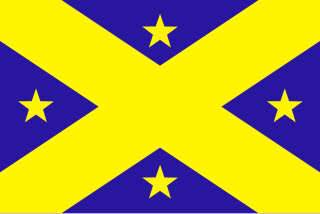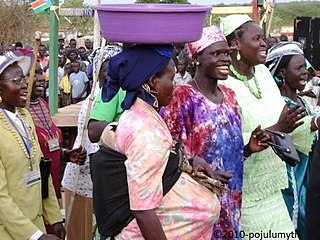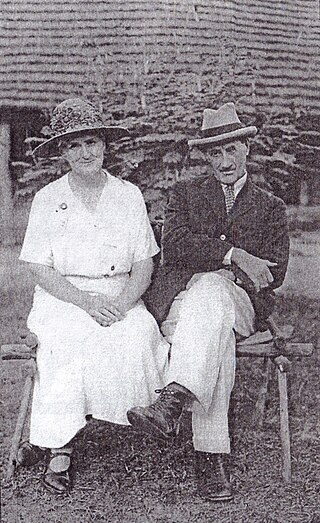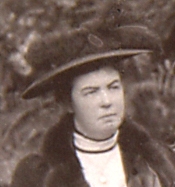
The Azande are an ethnic group in Central Africa speaking the Zande languages. They live in the south-eastern part of the Central African Republic, the north-eastern part of the Democratic Republic of the Congo, and the south-central and south-western parts of South Sudan. The Congolese Azande live in Orientale Province along the Uele River; Isiro, Dungu, Kisangani and Duruma. The Central African Azande live in the districts of Rafaï, Bangasu and Obo. The Azande of South Sudan live in Central, Western Equatoria and Western Bahr al-Ghazal States, Yei, Maridi, Yambio, Tombura, Deim Zubeir, Wau Town and Momoi.

Equatoria is the southernmost region of South Sudan, along the upper reaches of the White Nile and the border between South Sudan and Uganda. Juba, the national capital and the largest city in South Sudan, is located in Equatoria. Originally a province of Anglo-Egyptian Sudan, it also contained most of northern parts of present-day Uganda, including Lake Albert and West Nile. It was an idealistic effort to create a model state in the interior of Africa that never consisted of more than a handful of adventurers and soldiers in isolated outposts.

The Emin Pasha Relief Expedition of 1887 to 1889 was one of the last major European expeditions into the interior of Africa in the nineteenth century. Led by Henry Morton Stanley, its goal was ostensibly the relief of Emin Pasha, the besieged Egyptian governor of Equatoria, who was threatened by Mahdist forces.

The Lado Enclave was a leased territory administered by the Congo Free State and later by the Belgian Congo that existed from 1894 until 1910, situated on the west bank of the Upper Nile in what is now South Sudan and northwest Uganda. Its capital was the town of Lado.

Juba is the capital and largest city of South Sudan. The city is situated on the White Nile and also serves as the capital of the Central Equatoria State. It is the most recently declared national capital and had a population of 525,953 in 2017. It has an area of 52 km2 (20 sq mi), with the metropolitan area covering 336 km2 (130 sq mi).

The Mà'dí are a Central Sudanic speaking people that live in Magwi County in Eastern Equatoria, South Sudan and the districts of Adjumani and Moyo in Uganda. From south to north, the area runs from Nimule, at the South Sudan-Uganda border, to Nyolo River where the Ma’di mingle with the Acholi, the Bari, and the Lolubo. From the east to west, it runs from Parajok/Magwi to Uganda across the River Nile.

The Avukaya are an ethnic group of South Sudan. Some members of this ethnic have fled to the Democratic Republic of the Congo due to persecution. About 50,000 members of this ethnic group live in South Sudan. Many members of this ethnic group belong to the Christian minority of South Sudan. The Avukaya traditionally live in a rain-forest area in Equatoria close to the Democratic Republic of Congo in Southern Sudan.
The Tennet people are South Sudanese. Their language is sometimes referred to as Ngaarit. Tennet traditional dances are divided into the following categories: Lalu, Nyaliliya, Loduk, and so on

The Keliko or Kaliko are an ethnic group in South Sudan and the Democratic Republic of the Congo, with immigrants in Uganda. Most members of the Keliko are Christians. In the Democratic Republic of the Congo, they are called kaliko umi, more especially from Laibo, Mado, awubha awuzi and so on. There is a slight pronousation between Kaliko people in South Sudan and those in the DRC.
The Province of the Episcopal Church of South Sudan, formerly known as the Episcopal Church of Sudan, is a province of the Anglican Communion located in South Sudan. The province consists of eight Internal Provinces and 61 dioceses. The current archbishop and primate is Justin Badi Arama. It received the current naming after the inception of the Province of the Episcopal Church of Sudan, on 30 July 2017.

The Pojulu is a tribe of the savanna lands in the White Nile Valley, in the Equatoria region of South Sudan. They are Nilotic people and part of the Karo people — which also includes Bari, Mundari, Kakwa, Kuku, Nyangwara, and the Karo Tribes Of Omo Valley in Ethiopia such as the Banna, Hamer, Mursi, Kara, Dassanech, Arbore, Nyangatom known as the Omo Karo peoples.

Kenneth Grant Fraser O.B.E., M.D., Edin., D.P.H., F.R.C.S.E. or "Dr Fraser" as he is commonly remembered, was a Scottish missionary doctor and educator in Southern Sudan, specifically working among the Moru people.
The Nyangwara or Yangwara are a Nilotic ethnic group numbering between 25,000 and 30,000 people living in the South Sudan in the state of Central Equatoria. The word Yangwara means Horns. They live divided between Terekeka and Juba Districts. Their main town is Rokon, which lies about 53 miles west of Juba. Environment, Economy and Natural Resources Yangwara land enjoys tropical to rich savannah type of climate. It is endowed with deep fertile soil and is dissected by a number of perennial streams that drain into the river Nile. It receives rains between March and November enough to sustain extensive agricultural activities in the area.
Archdeacon Archibald Shaw was a pioneer missionary amongst the Dinka people with the Gordon Memorial Sudan Mission of the Church Missionary Society (CMS) in southern Sudan in the first half of the 20th century.

Constance Watney, MBE, COC, SRN, MBCN, was a British born missionary nurse in Uganda.

South Sudan is home to around 60 indigenous ethnic groups and 80 linguistic partitions among a 2021 population of around 11 million. Historically, most ethnic groups were lacking in formal Western political institutions, with land held by the community and elders acting as problem solvers and adjudicators. Today, most ethnic groups still embrace a cattle culture in which livestock is the main measure of wealth and used for bride wealth.
Lui is a town located in Mundri East County, Western Equatoria State, Sudán do Sur. Other nearby towns include Mundri, Amadi, Kediba, Lakamadi and Jambo.

Katherine Watney was a British-born missionary nurse in China.

The Greeks in South Sudan represent the Omogenia in what became the Republic of South Sudan in 2011. The population is tiny in number – estimated at around 90 – but historically played an important role and has some prominent members, especially First Lady Mary Ayen Mayardit.

















